Fashion Events Market Research, 2032
The global fashion events market size was valued at $33.6 billion in 2022, and is projected to reach $61.5 billion by 2032, growing at a CAGR of 5.3% from 2023 to 2032.
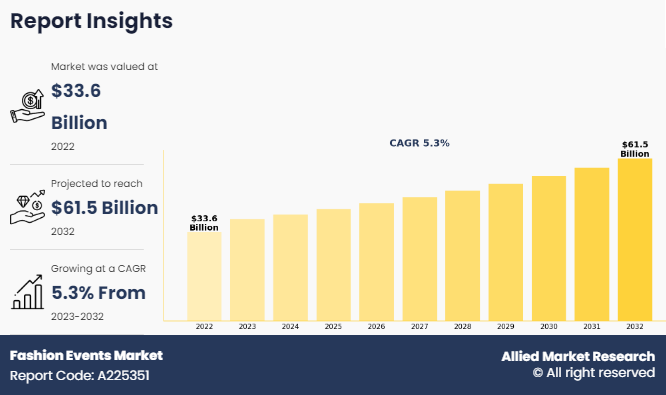
MARKET DYNAMICS
The digitalization of fashion events is one important dynamic. The COVID-19 pandemic has accelerated the fashion industry's sudden shift toward digital platforms. Virtual fashion displays, livestreaming, and digital showrooms have all become essential components of fashion events as they embrace technology more and more. The reach of fashion events has increased as a result of the digital revolution, enabling businesses to interact with a global audience. It has also democratized access to fashion, enabling customers to take part in events and experience them like never before. The incorporation of augmented reality (AR) and virtual reality (VR) experiences is anticipated to become more widespread as technology develops, further boosting the immersive quality of fashion events.
Another major driver in the industry for fashion events is sustainability. Fashion shows are being pushed to embrace more sustainable techniques as concerns about the environment rise. This involves utilizing eco-friendly materials in runway collections, reducing waste during event production, and incorporating ethical and sustainable fashion practices into event themes. The industry's dedication to minimizing its environmental impact is shown in the rise of sustainability-focused fashion events and conversations on ethical design decisions.
The market dynamics of fashion events have also shifted to place a strong emphasis on inclusivity and diversity. The industry has changed as a result of efforts to increase the presence of different ethnicities, body shapes, genders, and abilities on runways and in activities associated with fashion. Fashion shows that promote diversity and inclusivity typically receive more support from stakeholders in the business as well as from customers. This change is a result of shifting societal ideals and the requirement that the fashion business represents a wider variety of voices and viewpoints.
The market has changed significantly as a result of COVID-19. The pandemic drove numerous fashion shows to switch to virtual formats, disrupting established event models. While live events are progressively making a comeback, the pandemic's lessons have prompted the rise of hybrid events, which combine live and virtual components. Events are still planned with a focus on health and safety, and more stringent guidelines like contactless check-ins and social segregation policies are still in place.
Participation and engagement from consumers have developed into important dynamics. Pop-up shops, exclusive previews, and interactive experiences are some of the ways that fashion shows today try to directly interact with their audience. With businesses and designers using digital channels to connect with customers and foster a sense of community, social media plays a critical role in generating enthusiasm and anticipation for events.
Additionally, there is a lot of rivalry in the fashion events market. Prestigious fashion weeks are held in major fashion hubs like Paris, Milan, London, and New York and attract well-known designers and businesses. Emerging fashion hubs all around the world are competing for attention, escalating competition between local and foreign talent. The dominance of conventional hubs has been challenged by the growth of regional fashion weeks in Asia, the Middle East, and other locations. Emerging designers and companies can now become more visible because of digital disruption, but it has also increased competition for online attention and sales.
The fashion events industry is driven by innovation. Innovative and creative brands and designers stand out and draw attention, whether they use immersive technology like virtual showrooms or special partnerships with musicians and artists. Innovative lighting and staging methods, as well as environmentally safe and sustainable materials, are becoming more and more crucial in the event production industry. As a result, the fashion events market is a dynamic and quickly changing industry that is influenced by numerous factors. The dynamics of the market are shaped by the ongoing digital revolution, sustainability requirements, inclusivity and diversity programs, long-lasting effects of COVID-19, consumer engagement methods, fierce rivalry, and dedication to innovation. In a constantly shifting industry environment, fashion events must remain flexible and receptive to these changes.
SEGMENTAL OVERVIEW
The global fashion events market is analyzed on the basis of type, revenue source, organizer, and region. By type, the market is divided into fashion shows, trade shows/exhibitions, fashion contests, and others. By revenue source, the market is segmented into ticket sale, sponsorship, and others. Depending on the organizer, it is classified into fashion houses, fashion designers, event management companies, and others. Region wise, the fashion events market is analyzed across North America (the U.S., Canada, and Mexico), Europe (Germany, France, the UK, Italy, Spain, Russia, Netherlands, and the rest of Europe), Asia-Pacific (China, Japan, South Korea, India, Australia, and the rest of Asia-Pacific), and LAMEA (Brazil, Argentina, Saudi Arabia, South Africa, United Arab Emirates, and the rest of LAMEA).
BY TYPE
As per type, the fashion shows segment dominated the global fashion events market in 2022 and is anticipated to maintain its dominance throughout the fashion events market forecast period. Several major trends are influencing fashion shows in the market for fashion events. Global accessibility is being offered by the emergence of virtual and hybrid formats. Eco-friendly products and zero-waste methods are gaining popularity as sustainability becomes more and more important. With a wider variety of models and designers, diversity and inclusivity are honored. The viewing experience is improved by the incorporation of technology, such as augmented reality and live streaming. Interactive components like pop-up shops and immersive experiences increase consumer engagement. With contactless transactions and improved cleanliness controls, health and safety precautions remain crucial. The future of fashion shows is further shaped by developments in fashion technology, customized experiences, and industry partnerships.
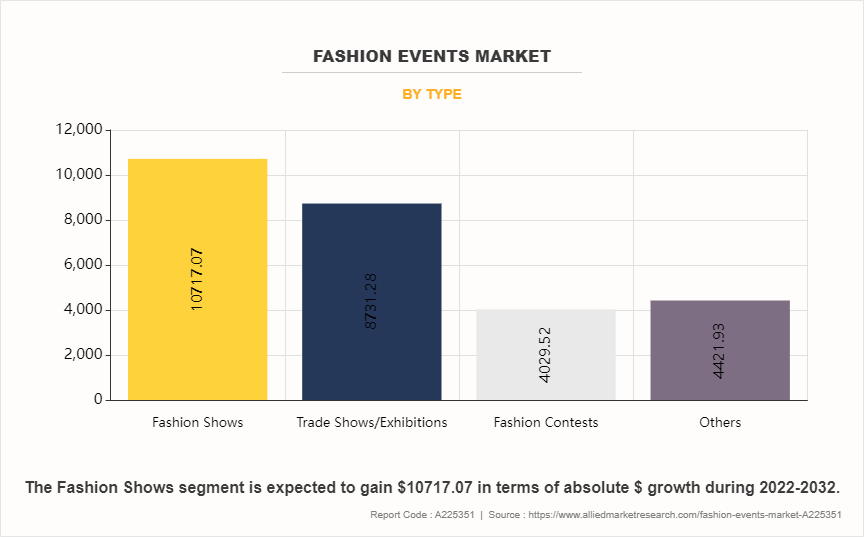
BY REVENUE SOURCE
The sponsorship segment dominated the global fashion events market in 2022. Sponsors look for genuine relationships with fashion events that share their values and emphasize sustainability, diversity, and inclusiveness. Virtual and hybrid events provide distinctive sponsorship opportunities, including digital showrooms and interactive content. Sponsors are increasingly able to successfully target particular consumer categories due to data-driven sponsorships. In addition, non-fashion companies including tech and health companies are increasingly sponsoring fashion events, widening the event's experience for guests and opening up new revenue streams.
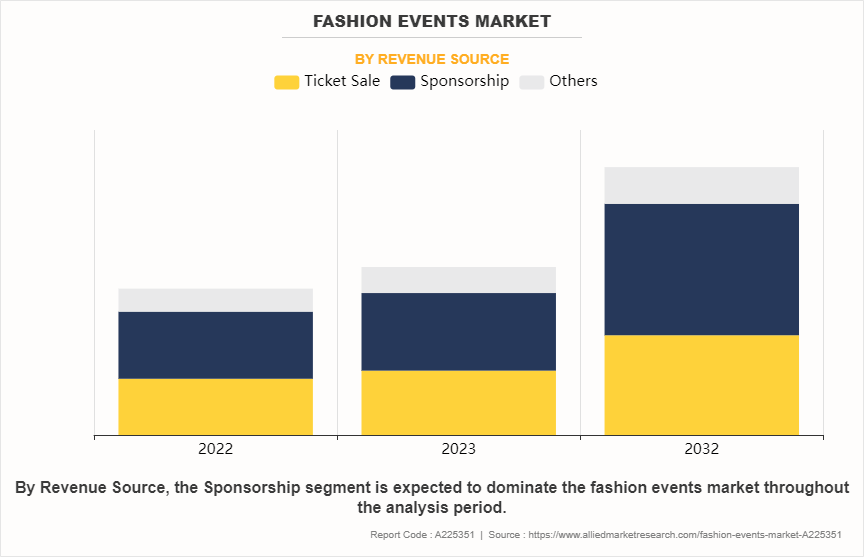
BY ORGANIZER
The fashion designers segment is predicted to show the fastest fashion events market growth during the forecast period (2023-2032). The rise of e-commerce and rapid digitization gives designers additional opportunities for sales. Sustainability continues to be a major trend, increasing demand for environmentally friendly products and moral behavior. Diversity and inclusivity are essential for creating novel design ideas. This is driving the fashion events market demand. Unique creative opportunities are provided through collaboration with the technology, art, and music industries. Influencer marketing's growth increases brand recognition. Events that combine physical and virtual elements increase designer exposure. Success in this dynamic industry requires the capacity to adjust to shifting consumer tastes and design healthy events.
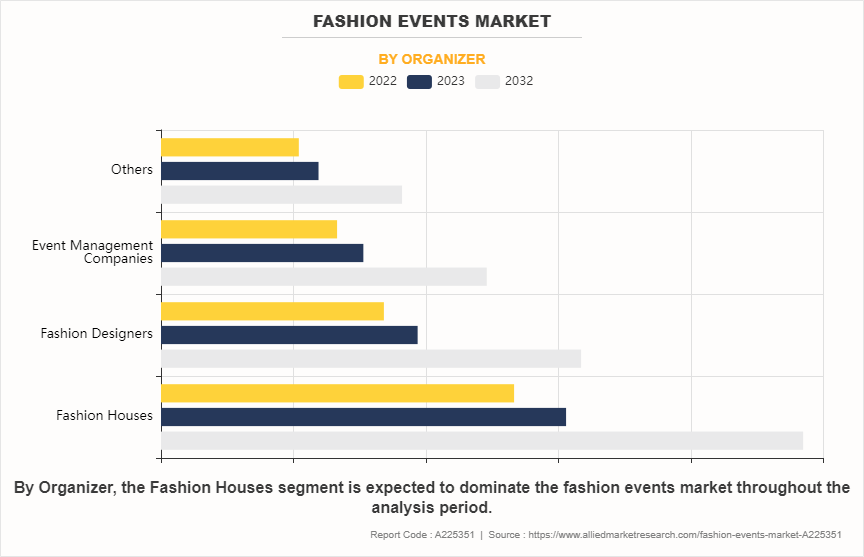
BY REGION
Region wise, Europe is predicted to dominate the market with the largest fashion events market share during the forecast period (2023-2032). Trends like sustainability, digital innovation, and inclusivity are driving the expansion of the European fashion events market for fashion designers. Sustainable fashion techniques, such as the use of environmentally friendly materials and ethical production, are becoming more significant. Their reach will increase if they embrace digital platforms for virtual entertainment and online shopping. The industry is also still being influenced by efforts to promote diversity and inclusiveness in design and runway representation. Collaborations with regional artisans and global visibility through occasions like Milan, Paris, and London Fashion Weeks will be crucial.
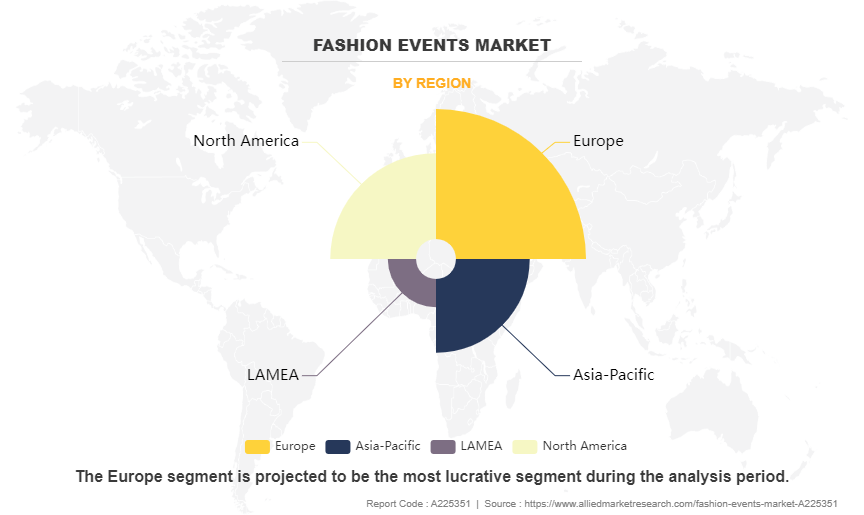
COMPETITION ANALYSIS
The key market players in the fashion events industry include IMG, Eventbrite, Inc., Production Resource Group, L.L.C., Fashion Nova, LLC, Reed Exhibitions Limited, Farfetch Limited, Fiera Milano S.p.A., Messe Frankfurt GmbH, Zalando SE, and GL Events Group.
Prestigious fashion weeks are held in major fashion hubs like Paris, Milan, London, and New York, which increases rivalry among well-known designers and businesses to land desired slots. New fashion cities are also competing for attention. Future fashion weeks in places like Asia and the Middle East threaten the supremacy of established fashion hubs by attracting both local and foreign talent. The fashion events market has been disrupted and opened up to a global audience due to virtual fashion events, live streaming, and e-commerce integration. The competition for online engagement and sales has increased as a result of the digital revolution.
As consumers want eco-friendly fashion events, companies that adopt sustainable methods have a competitive advantage. A wider audience is attracted to fashion events that value diversity and inclusivity in their runway shows, which encourages competition in the cause of advancing representation and acceptance. Innovative brands and designers stand out in a crowded market and attract attention. Examples of these experiences range from immersive technologies to unique collaborations.
It is critical to compete for consumer interest and involvement through interactive experiences, pre-event teasers, and social media promotions. Competition between local and international fashion events highlights the significance of addressing regional preferences while pursuing global recognition. It's fiercely competitive to secure sponsorships and agreements with premium companies, publications, and influencers as these alliances raise the profile of the event.
SOME EXAMPLES OF PRODUCT LAUNCH IN THE MARKET
- In September 2022, Fiera Milano S.p.A., launched a new fashion exhibition, namely, HOMI Fashion&Jewels Exhibition. This exhibition showcases jewellery and numerous fashion accessories with a participation of over 420 brands in the event.
- In May 2022, IMG (IMG Focus) announced programming for MADE x PayPal, which is a two-day fashion event. This event features fashion shows, performances, DJ sets and special appearances by Nas, Parris Goebel, Heron Preston, among others.
SOME EXAMPLES OF PARTNERSHIP IN THE MARKET
- In September 2021, Fashion Nova, LLC partnered with Afterpay, which is an Australian financial technology company in order to offer shoppers a more flexible way for the payments.
- In September 2023, Zalando SE extended its partnership with Copenhagen Fashion Week as its strategic partner for three years, 2024 to 2026.
Key Benefits For Stakeholders
- This report provides a quantitative analysis of the market segments, current trends, estimations, and dynamics of the fashion events market analysis from 2022 to 2032 to identify the prevailing fashion events market opportunities.
- The market research is offered along with information related to key drivers, restraints, and opportunities.
- Porter's five forces analysis highlights the potency of buyers and suppliers to enable stakeholders make profit-oriented business decisions and strengthen their supplier-buyer network.
- In-depth analysis of the fashion events market segmentation assists to determine the prevailing market opportunities.
- Major countries in each region are mapped according to their revenue contribution to the global market.
- Market player positioning facilitates benchmarking and provides a clear understanding of the present position of the market players.
- The report includes the analysis of the regional as well as global fashion events market trends, key players, market segments, application areas, and market growth strategies.
Fashion Events Market Report Highlights
| Aspects | Details |
| Market Size By 2032 | USD 61.5 billion |
| Growth Rate | CAGR of 5.3% |
| Forecast period | 2022 - 2032 |
| Report Pages | 250 |
| By Type |
|
| By Revenue Source |
|
| By Organizer |
|
| By Region |
|
| Key Market Players | GL Events Group, Zalando SE, Messe Frankfurt GmbH, Production Resource Group, L.L.C., Fashion Nova, LLC, Eventbrite, Inc., Farfetch Limited, IMG, Reed Exhibitions Limited, Fiera Milano S.p.A. |
Analyst Review
The perspectives of the leading CXOs in the fashion events industry are presented in this section. The fashion events market is a vibrant industry that acts as a crucial hub for the international fashion sector. This market provides a venue for designers, enterprises, and fashion enthusiasts to gather and celebrate creativity, style, and innovation. It includes a wide range of activities, from high-profile runway shows and exhibitions to trade expos and cultural festivals. The fashion events market is always evolving, which is one of its distinguishing characteristics. These events' format and themes frequently reflect fashion trends, with diversity, environmental consciousness, and technological integration becoming increasingly popular in recent years. Since sustainability has become more prominent, numerous events have adopted eco-friendly procedures and highlighted sustainable fashion brands. An inclusive and diverse fashion environment has been developed as a result of inclusivity initiatives that have increased diversity in model casting and design representation. The way viewers interact with fashion content has also changed because of the incorporation of technology, such as augmented reality (AR) and virtual reality (VR).
The industry for fashion events offers an extensive range of commercial prospects in addition to the runway. Designers and brands use it as a platform to introduce new collections, establish partnerships, and grow their consumer base. Additionally, it significantly boosts regional economies by bringing in tourists and bringing in money from retail sales, sponsorships, and ticket sales. Fashion events continue to be crucial in influencing trends, encouraging innovation, and promoting economic growth in a period in which fashion is both a cultural expression and a global enterprise. The market for fashion events will develop alongside fashion, continuing to be an appealing and significant factor in the world of fashion and design.
The global fashion events market was valued at $33,590.4 million in 2022, and is projected to reach $61,490.2 million by 2032, registering a CAGR of 5.3% from 2023 to 2032.
The forecast period in the Fashion events market report is 2023 to 2032.
The base year calculated in the Fashion events market report is 2022.
The top companies analyzed for the Fashion events market report are IMG, Eventbrite, Inc., Production Resource Group, L.L.C., Fashion Nova, LLC, Reed Exhibitions Limited, Farfetch Limited, Fiera Milano S.p.A., Messe Frankfurt GmbH, Zalando SE, and GL Events Group.
The fashion shows segment is the most influential segment in the Fashion events market report.
Europe holds the maximum market share of the Fashion events market.
The company profile has been selected on the basis of key developments such as partnership, product launch, merger and acquisition.
The market value of the Fashion events market in 2022 was $33,590.4 million.
Loading Table Of Content...
Loading Research Methodology...


